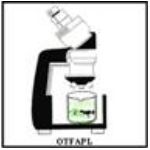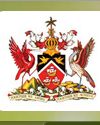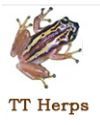AGLS 6502 Lecture 21.7 - Know More About Snakes in General
There are an estimated 2500 to 3000 species of snakes distributed throughout the world. They are most common in warm areas and reach their greatest abundance in the tropics. Some dwell in burrows beneath the ground, other live most of their lives in trees. Some may be found in humid forests or dry deserts and others still, inhabit the sea never leaving even to reproduce.
There are approximately 37 [37 to 44, depending on the author] species of snakes in Trinidad and Tobago. There may be as much as 41 in Trinidad and 22 in Tobago, with 19 species common to both Trinidad and Tobago [Garcia and Blanc, unpublished]. Not all of these are venomous. There are only 4 venomous species in Trinidad and none in Tobago.
All are useful to humans in some way, as protectors of our food crops, e.g. snakes destroy rats, mice, and other vermin found in warehouse and gardens. Snakes also destroy pests as; squirrels and corn birds, which destroy cocoa, coffee and corn on estates and plantations. Snakes are also used in the field of medicine e.g. anti venom is produced from the snake’s own venom, and this is used to save lives.
The U.S. Food and Drug Administration (FDA) have recently approved usage of the drug integrilin manufactured from the venom of rattlesnakes. This drug is used in the treatment of people suffering from unstable angina and from heart attacks.
Rationale
A lack of knowledge on the identification of snakes is the manufacture of certain fear in humans. Superstition accounts for others. Crude treatment of snakebites serves only to compound and/complicate a painful and frightening situation.
Objectives
The objectives of this paper are as follows:
- to briefly describe the function of venom manufactured by snakes and usage by the medical world;
- to give a brief identification and common habits of some snakes in Trinidad and Tobago;
- to offer some relief by way of first aid and treatment o\to snakebite victims; and
- to recommend some safety precaution which could lesson the chances of being bitten by snakes.
Venom is a substance produce by venomous snakes, which serves the function of rapidly incapacitating or killing prey while acting as a pre-digestant. There are basically two types of snake venom; haemotoxins which affects blood and/or tissue and neurotoxins which affect the victim’s nervous system.
However, there are quite a number of anti venoms available to ensure swift and proper treatment of an envenomated victim or victims of snakebites. Some of popular antivenom made by local elders who believe in its curative powers serve only in a placeborial capacity.
21.7.3 The Venomous Snakes of Trinidad and Tobago
There are two groups of venomous snakes in Trinidad, Pit Vipers and Coral Snakes.
There are two (2) Pit Vipers found in Trinidad. They are the Bush Master [Lachesis muta muta] and the Fer-de- lance [Bothrops asper/B. athrox]. They have long movable fangs which when not in use fold back into a sheath on the roof of the mouth. The fangs unfold and stand erect at the front of the mouth as the snake strikes. Our two (2) venomous mapepires have venom, which is of a haemotoxic nature affecting the blood and or tissue of its victim.
Pit vipers are characterized by the presence of a thermo-receptive pit or hole, know as the Loreal Pit located between the nostrils and eyes. This is used for sensing the body heat of its victim or prey.
1] The Bush Master – Lachesis muta muta
The bush Master (local name: Mapepire ‘z’ ananna) is the longest Pit Viper in the World. It occasionally exceeds 15 feet. Its rasp like or scale like skin is pinkish or light brown with a pattern of dark brown blotches in a triangular pattern. The Bush Master is a pit viper and the only species of viper in the Americans that lay eggs. It lays about 6 to 12 eggs.
The snake occurs sporadically in forested from Costa Rica to Brasil and Trinidad, frequently lurking in mammal burrows. When distributed, the snake moves toward the intruder, often vibrating its tail rapidly. Its bite is serious because of its long fangs and the large amount of poison released. This snake, however, requires delicate handling in captivity.
2] Fer-De-Lance – Bothrups asper/B. Atrox
The other pit viper/venomous mapepire known in Trinidad is the Fer-de-Lance (local name: Mapepire Blasaine). The word Fer-de-Lance means head of the lance. The Fer-de-Lance head is shaped like that of a lance or spear. Its skin colour is a mixture of light green and greys with a series of white “X” like markings on the back and extend down the side of its body.
As its scales are raised, it is not a smooth skinned snake. The Fer-de-Lance moves swiftly and it could strike at a moving object with blinding speed, even in the darkness of night using the loreal pit to target its intended victim. The symptoms of a mapepire bite are very frightening, but with snakebite serum or anti venom as it is referred to and professional medical care the effects can be counteracted.
The two local venomous coral belong to the Elapids family; i.e. their venom is of a neurotoxic nature. It affects the nervous system.
1] The Common Coral – Micrurus circinalis
The smaller of the two local Coral snakes, attain a length of 12 inches and bears the colours; red, white and black arranged in the pattern of our National Flag.
2] The Large Coral Snake – Micrurus lemniscatus diutius
The larger Coral can attain a size of 50 inches, (largest one caught is 48 inches) and has more potent venom than its smaller cousin. It has the colours; red, black light yellow (or white to creamish), black and red. Its colours are arranged in the following sequence; red, black, light yellow, black and red. This snake should not be played with because of its extremely dangerous venom.
21.7.4 Some Non-Venomous Snakes of Trinidad and Tobago
There are four (4) Boid species of snake in Trinidad and Tobago. All four are present in Trinidad and only three (3) are present in Tobago. The Anaconda is not found in Tobago.
1] The Boa Constrictor [Red Tailed Boa] – Boa constrictor constrictor
The Boa Constrictor or Macajuel as this snake is commonly called, is frequently seen in and around the garden, in the street and sometimes the first one you would see in the bush. It is not a venomous snake, and should not be killed, for it destroys rats and mice that carry diseases that can be fatal.
It can be recognized by its dark brown hour-glass pattern on a light brown background on its back, which gets smaller as it gets nearer to the tail and takes on a rust-red and yellowish or cream closed pattern.
It can be recognised by its dark brown hour-glass pattern on alight brown background on its back, which gets smaller as it gets nearer to the tail and takes on a rust-red and yellowish or cream closed pattern.
This snake grows to approximately 16 feet and gives birth up to 65 mops (babies). It is sometimes, aggressive when encountered and may bite if given the opportunity. However, it should not be killed, as this snake is a protected species.
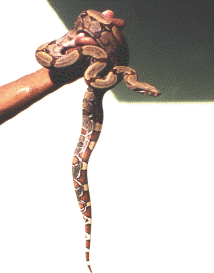
2] Anaconda – Eunectes murinus gigas
The Anaconda (local name Huille) pronounced Wheel is the largest snake found in Trinidad and Tobago and can attain a length of 30 feet. It is a semi aquatic snake and can consume its food in the water quite easily.
The Huille lives in the swampier regions. It is a thick-bodied snake (it can weigh up to 300 LB) identified by its green or brown coloured skin with darker green spots or blotches. These spots can appear to be dark brown or even appear to be black depending on its environment in the swamp.
The Anaconda is not a venomous snake, and is protected under the wildlife act of Trinidad and Tobago.
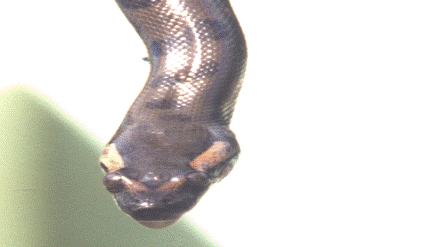
3] The Cascabel/Cooks Tree Boa – Corallus enydris cookii
Common Name, Cookstree Boa Cascabell Dormillioon Mapanare
One of the more ill tempered snake someone can encounter on a hunting expedition, the cascabel. Features:
- brown with a yellow chin and belly sometimes light green and mildly patterned, at times, uniformed light brown with cream underside.
- Slender body 1 ½“ to2” radius long narrow neck with a large distinct head long slender tail with which it anchors, when striking its prey from tree tops where it spends most of its time.
It is found on estates in trees hanging over water asleep during the day and emerges from the onset of darkness to feed on small mammals and birds that come to rest. They will also feed on bats, and squirrels that destroy the farmer crop. However this snake is not venomous and should not be killed.
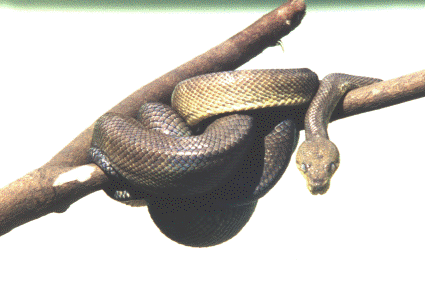
4] The Rainbow Boa – Epicrates cenchria maurus
Common Name Jack, Velvet Mapepire
The rainbow boa is noted for its iridescence of skin more so when skin has recently been shed and it emerges into the sun sight on some rear occosion this snake is brown with a white or cream under side. There are darker ring like marking on the back of the snake which are clearer on the juveniles.
This snake feeds mainly at night on rats and mice which they, kill by constriction. This way they are helping the farmer and the general populace by ridding us of these pests that would otherwise destroy our food crops and contaminate our unprotected food stuff. The rainbow boa is not a venomous snake and should be protected for the good it does.
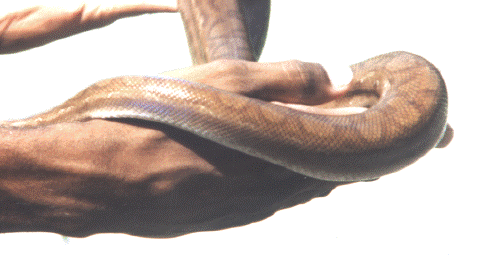
5] The Black Cribo – Clelia clelia
The Cribo is a friend. It eats other snakes including poisonous ones. Both Mapepire Balsaine and Z’ananna are included in its diet and hunters and gardeners would feel happy to see this snake around. It is not poisonous and is less aggressive than some of the other snakes we may encounter.
The Cribo is black in colour with a white underside. It is thick bodied with a somewhat pointed snout and has small eyes. The neck is almost non-distinguishable. This snake can attain a length of 6 feet. It is seldom seen and should be protected.
6] False Mapepire – Leptodeira annulata ashmeadii
The False Mapepire is the snake most seen in home gardens and on the lawn mainly at night. It bears a superficial resemblance to the venomous Mapepire Balsaine. However the snake is not a venomous species and they seldom bite.
The snake is light brown in colour with a series of dark spots and elongated blotches on its back and grows to a length of 3 feet and is slim. It is not a rough or raised-scaled snake like its venomous cousin.
21.7.5 First Aid and Treatment of Snakebites
If someone is bitten and you are able to assist, don’t panic, you must keep calm. You must reassure the victim that you are able to help and they will live. Try to keep the victim from panicking.
In your efforts try to determine if the offender was a venomous snake, it very well may not have been. If it was a venomous snake, immobilize the victim and carry him or her to the nearest medical facility for treatment. Should you determine that the offender was not venomous, the victim should still be taken to the nearest medical facility.
Never slice into the victims flesh, lacerations by untrained people can sever nerves or major blood vessels. The victims can loose limbs, fingers or toes, only to find out it was a non-venomous snakebite.
Do not attempt to suck out the venom with your mouth, venom can enter the blood by ways of cuts in the mouth or holes in the teeth.
Transport victim to nearest Medical Facility
Do Not Delay Evacuation.
The snakes you may encounter at some time or the other may be dangerous. Do not try to handle them unless you know the species you are dealing with and are familiar with snakes. Therefore let me recommend the following safety precautions, which could lessen the chances of one being bitten:
- Wear proper footwear and appropriate clothing.
- Do not wander off or go hiking in the forest alone; look for company.
- Do not try to corner or surprise a snake.
- Do not play with venomous snakes or insects.
- Pay attention to where you put your hands and feet when walking.
- Do not put your hands into holes in the ground or into logs and tree trunks.
- Do not Delay Evacuation to a professional medical facility or private practitioner
In conclusion snakes fear people just as much as people fear snakes; they would run away if given the opportunity. All snakes are protected by law and should not be killed.
For further information contact:
Sgt. Anthony Garcia., 39 Diamond Gardens, El Dorado Gardens, El Dorado, Trinidad, Trinidad and Tobago, W.I.
Phone: 662-4556/ 758-8426
Other Contacts:
1] Wildlife Section, Forestry Division, Ministry of Lands and Marine Resources
2] Emperor Valley Zoo
- de Vosjoli, P ( 1990): The General care and Mainatainance of RED- TAILED BOAS. The Herpetocultural Library Series 200, Advanced Vivarium Systems, Lakeside CA, USA, pages.
- de Vosjoli, P ( 1991): The General care and Mainatainance of Burmese Pythons including notes on other large pythons. e Herpetocultural Library Series 200, Advanced Vivarium Systems, Lakeside , CA, USA, pages.
- de Vosjoli, P; Klingenberg, R., Barker, T. and Barker, D. ( 1995): The Ball Python Manual Advancd Vivarium Systems Inc, Santee , CA, USA, 78 pages
- Balsai, M. ( 1992): The General care and Mainatainance of Savanna Monitors and other popular Monitor speciesThe Herpetocultural Library Series 400, Advanced Vivarium Systems, Lakeside , CA, USA55 pages.
- Frank, W. ( 1979 ): Boas and other non-venomous snakes.TFH Publications Inc., Ltd, Surrey, Great Briton. 91 pages
- Griehl, K.( 1984): Snakes: Giant Snakes and Non-venomous Snakes in the Terrarium: A Complete Pet Owners ManualBarron’s Educational Series, Inc., New York, USA, 80 pages.
- Mehrtens, J. M. (1987): Living Snakes of the World in colour. Sterling Publishing Company Inc, New York.
- Ross, R. A. (1990) : The Reproductive Husbandry of Pythons and Boas.
The Institute for Herpetological Research, Stanford , CA. USA - Russo, E. A. (1987): Diagnosis and treatment of lumps and bumps in snakes. Compendium Small Animal 9: 795-802
- Stafford, P. J. (1986): Pythons and Boas. T. F. H. Publications Inc Ltd., Neptune City, N.J., USA
- Tolson, P.J. and Henderson, R. W ( 1993): The Natural history of west Indian Boas. R and A Publishing Limited, Somerset, England
125 pages.
Helpful Links, Photos, Videos and Multimedia
Helpful website: List of snake species found in Trinidad and Tobago
Helpful website: The Herpetofauna of Trinidad & Tobago. A listing of snakes with useful descriptions
Helpful website: The Online Guide to Animals in Trinidad and Tobago. A listing of snakes with useful descriptions
Video Aid: Learn more about the Bushmaster
Video Aid: The Search for the Ultimate Pit Viper, filmed in Costa Rica
